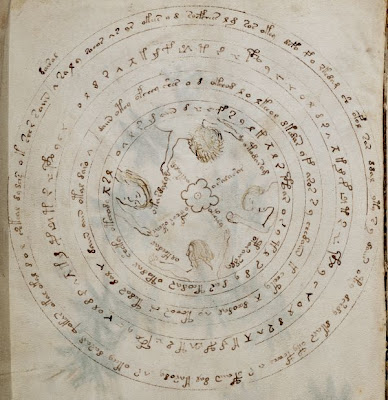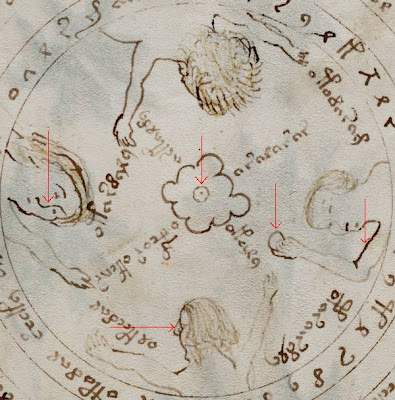 Voynich Manuscript, page f57v (the ‘magic circle’ page)
Voynich Manuscript, page f57v (the ‘magic circle’ page)
The reason I’ve been trying to find out about magic circles for years is because, as you can see above, page f57v in the Voynich Manuscript apparently contains one. Or (more precisely), whatever f57v actually contains, it seems on the surface to follow the constructional rules and layout of genuine magic circles. However, this is hard to research because the topic of magic circles has attracted relatively little academic interest over the years, Richard Kieckhefer’s (1997) Forbidden Rites (an in-depth study of a 15th century necromancer’s manual) being one of the few honourable exceptions. Which is why I was so excited about the lecture.
Having said that, there are many things about f57v that cast doubts on its ‘magic circle-itude’. For example, I could find no other magic circle with the directional spirits given faces rather than simply named: depictions in every other magic circle I had seen were instead abstract diagrammatic renderings (swords, pentacles, rings, sigils, etc), and names of the directions (to help orient the circle, the first thing any proper necromancer would want to do). But even more brutally: when magic circles are all about the power of names, why ever would someone want to replace them with images?
And so… after the lecture, I asked William for his thoughts on f57v (which, delightfully, he had looked at before). As far as the directional faces go, he agreed that this was pretty much a unique feature: though a tiny number of magic circles he had seen do have sigils shaped to broadly resemble faces, that would seem to be a completely different strand of development to that which we see in the VMs. Overall, even though he did note that it was intriguing that the postures of the four “people” on f57v were all different, the main impression the page left him with was that each of the four faces faced in a different direction (though he didn’t know what that meant).
On the train home, I sat there wondering what this might have caused this, letting all the various aspects swirl around me (though, no, I didn’t have any of Treadwell’s wine that night). And then all the bits clunked into place, with that sound very familiar to any Simpsons fan: “d’oh!”
I should explain. Perhaps the biggest trap Voynichologists fall into is that of overthinking issues: when many complex explanations for a given phenomenon exist, sometimes simple ones gets overlooked, or (worse) rejected for appearing too simple. And the simplest explanation here is that, because almost every magic circle has the directions of the compass written on it, that would be both the first thing you would want to keep and the first thing you would want to hide. And so it seems highly likely to me that the four faces on f57v code for N/E/S/W. In short, I think that (like the VMs’ “Naked Lady Code” I described in my book) the four faces employ a misleadingly elaborate way of enciphering something very simple – the compass directions. But which is which – and how – and why?
- The left figure is facing forward-left
- The top figure is facing backward-right
- The right figure is facing forward-right (and holding a ring / egg)
- The bottom figure is facing backward-left
But how do these four map onto N/S/E/W? The first thing to notice is that magic circles are very often written in Latin, with the four points written Oriens [E], Meridies [S], Occidens [W], Septentrio [N]: and so an encipherer would only need to hide one in order to hide them all.
While I don’t know for sure… I do predict that the nose and eyebrow of the left figure’s face was elaborated around an “S” to denote “Septentrio” [i.e. North]: and that the only useful information is that a ring (as rings are far more common than eggs in magic circles, The Black Pullet notwithstanding) should be placed opposite it [i.e. South]. The flower-like shape at the centre is probably an elaborated shape around the central o-shapes, which probably denote locus magistri, the place where the exorcist / conjuror / master of the magic circle should stand. Finally: might the heavily-drawn straight line on the shoulder of the ring-carrying person denote a sword? Very possibly.
 Voynich Manuscript, page f57v – four central figures
Voynich Manuscript, page f57v – four central figures
This doesn’t answer every question about f57v (how could it?): but it does give a good snapshot of my current thoughts on how (beneath all the deception) it is actually a magic circle (though perhaps not as complex a magic circle as you might initially think).
Part 2 will move on to the VMs’ other magic circles…